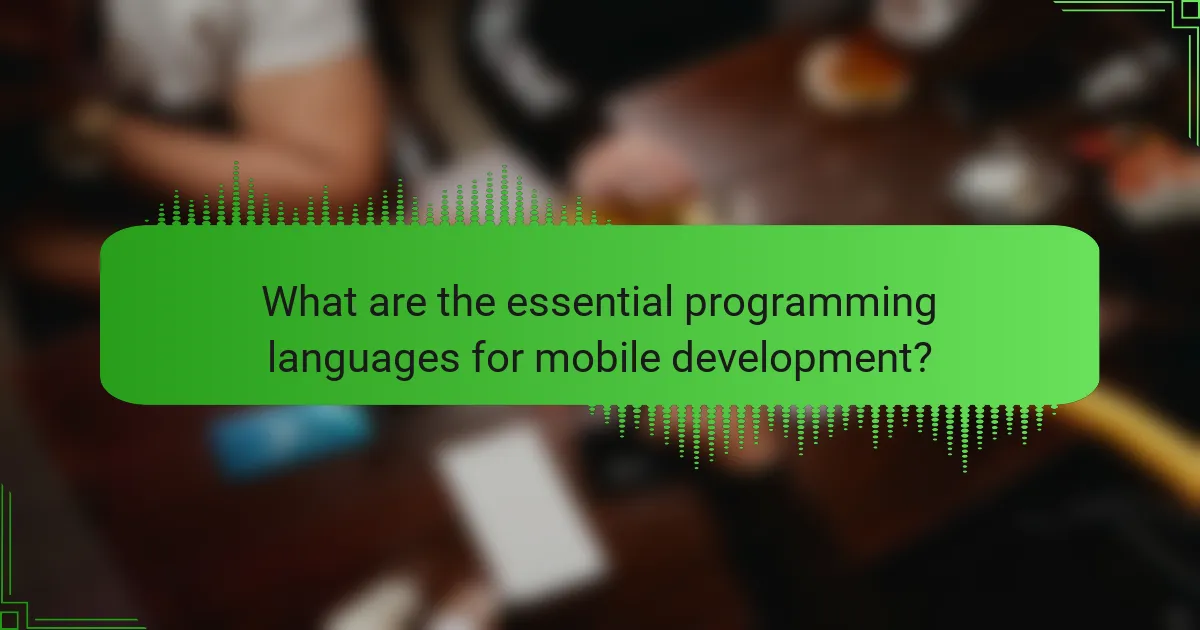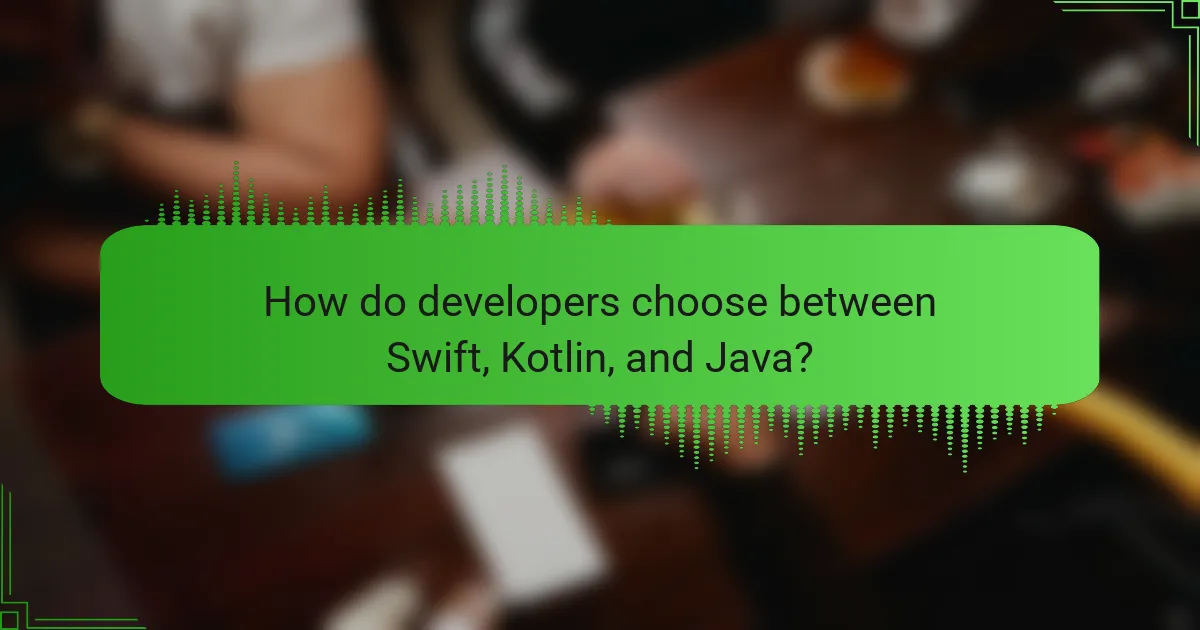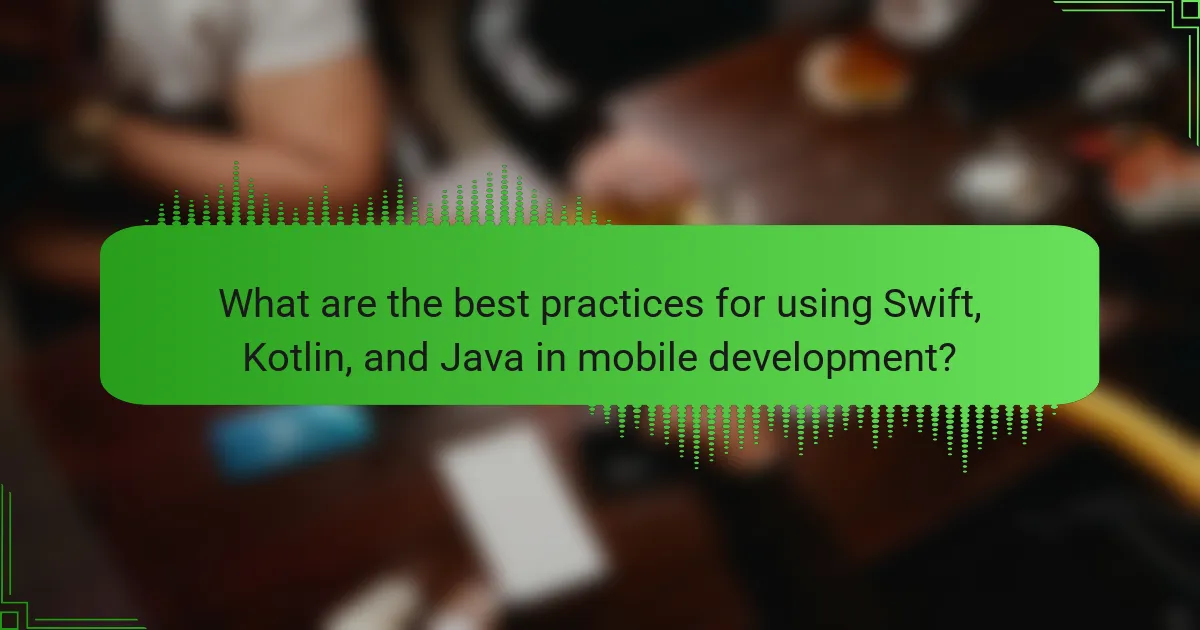The essential programming languages for mobile development are Swift, Kotlin, and Java. Swift is designed for iOS app development, emphasizing performance and safety. Kotlin is the preferred choice for Android applications, offering modern features and seamless interoperability with Java, which has been a staple for Android development for many years. This article explores the strengths of each language, factors influencing developers’ choices, and best practices for efficient mobile application development, including specific coding techniques to enhance productivity and code quality.

What are the essential programming languages for mobile development?
The essential programming languages for mobile development are Swift, Kotlin, and Java. Swift is primarily used for iOS app development. It is optimized for performance and safety. Kotlin is the preferred language for Android app development. It offers modern features and interoperability with Java. Java has been the traditional language for Android development for many years. It has a vast ecosystem and community support. These languages are crucial for building efficient and robust mobile applications.
Why are Swift, Kotlin, and Java considered essential?
Swift, Kotlin, and Java are considered essential for mobile development due to their widespread use and robust features. Swift is the primary language for iOS development, offering modern syntax and strong performance. Kotlin is the preferred language for Android development, providing seamless integration with existing Java code. Java has been foundational in mobile app development for over two decades, ensuring compatibility and a vast ecosystem. Each language supports extensive libraries and frameworks, enhancing development efficiency. According to the Stack Overflow Developer Survey 2023, these languages rank among the most loved and wanted, indicating their importance in the developer community. Their active support from major tech companies further solidifies their essential status in the mobile development landscape.
What unique features do Swift, Kotlin, and Java offer for mobile development?
Swift offers unique features like type safety and automatic memory management, enhancing code reliability and performance. Its syntax is concise, making it easier to read and write. Swift also supports protocol-oriented programming, promoting code reuse and flexibility.
Kotlin provides null safety, which reduces the risk of null pointer exceptions. It is fully interoperable with Java, allowing developers to use existing Java libraries seamlessly. Kotlin’s coroutines simplify asynchronous programming, improving app performance and responsiveness.
Java, a long-established language, offers extensive libraries and frameworks for mobile development. Its platform independence allows apps to run on various devices. Java’s large community provides extensive support and resources, making it a reliable choice for developers.
How do these languages compare in terms of performance and usability?
Swift generally offers superior performance due to its optimized compilation and advanced memory management. Kotlin provides a good balance of performance and usability, especially for Android development. Java, while widely used, can be slower compared to Swift and Kotlin due to its older architecture and garbage collection process. Usability-wise, Swift is known for its clean syntax and safety features, making it user-friendly for developers. Kotlin enhances usability with its interoperability with Java and concise syntax. Java, however, has a steeper learning curve due to its verbosity and legacy issues. In mobile development, Swift is ideal for iOS apps, Kotlin for Android, and Java is often used for legacy systems.
What are the primary platforms supported by these programming languages?
Swift primarily supports iOS and macOS platforms. It is designed for Apple’s ecosystem, enabling developers to create applications for iPhones, iPads, and Macs. Kotlin primarily supports Android platforms. It is officially supported by Google for Android app development, allowing for seamless integration with existing Java code. Java supports multiple platforms including Android, Windows, macOS, and Linux. It is a versatile language used for developing applications across various environments. Each language is tailored to its respective platform, ensuring optimal performance and user experience.
How does Swift cater specifically to iOS development?
Swift is designed specifically for iOS development by providing a modern syntax and safety features. It integrates seamlessly with Apple’s Cocoa and Cocoa Touch frameworks. Swift offers performance optimizations that enhance the speed of iOS applications. The language supports both object-oriented and functional programming paradigms. Swift’s type safety reduces runtime crashes, improving app reliability. Its interoperability with Objective-C allows developers to use existing libraries. Swift also includes powerful features like closures and generics, which simplify code writing. Apple’s strong support and extensive documentation further facilitate iOS development with Swift.
What advantages does Kotlin provide for Android development?
Kotlin offers several advantages for Android development. First, it is fully interoperable with Java, allowing developers to use existing Java libraries and frameworks seamlessly. This compatibility reduces the need for extensive code rewriting. Second, Kotlin’s concise syntax minimizes boilerplate code, leading to increased productivity and easier maintenance. Third, it includes null safety features that help prevent NullPointerExceptions, a common source of runtime errors in Java. Additionally, Kotlin supports functional programming constructs, enabling more expressive and flexible code. According to JetBrains, Kotlin is officially endorsed by Google as a first-class language for Android development, which enhances its adoption in the developer community. These advantages collectively improve development efficiency and software quality in Android projects.
Why is Java still relevant in mobile development today?
Java remains relevant in mobile development today due to its extensive use in Android application development. It is the primary language for Android, which holds over 70% of the global smartphone market share. Java’s robust ecosystem includes libraries, frameworks, and tools that facilitate mobile app development. It offers strong community support, ensuring developers can find solutions and resources easily. The language’s stability and performance are also key factors, as many legacy applications still operate on Java. Furthermore, Java’s cross-platform capabilities allow for broader application reach. These attributes collectively reinforce Java’s ongoing significance in the mobile development landscape.

How do developers choose between Swift, Kotlin, and Java?
Developers choose between Swift, Kotlin, and Java based on project requirements and platform compatibility. Swift is preferred for iOS development due to its performance and safety features. Kotlin is favored for Android development because it is fully interoperable with Java and offers modern programming features. Java remains popular for cross-platform applications and legacy systems. Developers consider factors like community support, ease of learning, and available libraries. Swift has a growing community and extensive documentation. Kotlin’s concise syntax enhances productivity. Java’s long-standing presence provides stability and a wealth of resources. Ultimately, the choice depends on the specific needs of the application and the target operating system.
What factors influence the choice of programming language for mobile apps?
The choice of programming language for mobile apps is influenced by several factors. Key factors include platform compatibility, performance requirements, and developer expertise. Platform compatibility determines whether the language is suitable for iOS, Android, or cross-platform development. Performance requirements affect the efficiency and speed of the app. Developer expertise refers to the familiarity and skill level of the development team with specific languages. Additionally, community support and available libraries can impact the decision. For example, Swift is preferred for iOS due to its integration with Apple’s ecosystem. Kotlin is favored for Android development because of its modern features and interoperability with Java.
How do project requirements dictate the selection of a programming language?
Project requirements significantly influence the choice of a programming language. Specific needs such as platform compatibility, performance, and development speed guide this selection. For example, mobile applications often require languages optimized for their respective platforms. Swift is preferred for iOS due to its integration with Apple’s ecosystem. Kotlin is favored for Android development because of its interoperability with Java. Performance requirements may dictate low-level languages for resource-intensive applications. Additionally, team expertise can determine language choice; familiarity with a language can accelerate development. Ultimately, aligning the programming language with project goals ensures efficient and effective outcomes.
What role does developer expertise play in language selection?
Developer expertise significantly influences language selection in mobile development. Experienced developers tend to choose languages that align with their skills. For instance, a developer proficient in Swift is likely to favor it for iOS applications. Conversely, a developer well-versed in Kotlin may prefer it for Android projects. Familiarity with a language can enhance productivity and reduce development time. Research indicates that expertise directly correlates with code quality and maintainability. A study by the ACM found that skilled developers produce code with fewer bugs. Thus, developer expertise plays a crucial role in effective language selection for mobile development.
What are the community and resource considerations for each language?
Swift, Kotlin, and Java each have distinct community and resource considerations. Swift benefits from a strong community backed by Apple. This community provides extensive resources, including documentation and forums. Kotlin has a growing community supported by JetBrains and Google. It offers numerous libraries and online courses. Java boasts one of the largest programming communities globally. This extensive network provides vast resources, including tutorials, forums, and open-source libraries. Each language’s community influences its adoption and resource availability, impacting developers’ experiences.
How does the availability of libraries and frameworks impact language choice?
The availability of libraries and frameworks significantly influences language choice in mobile development. Developers often prefer languages that have robust libraries and frameworks to streamline their work. For instance, Swift offers extensive frameworks like UIKit and SwiftUI, enhancing iOS development efficiency. Kotlin, with libraries such as Ktor and Anko, simplifies Android app development. Java’s long-standing libraries, like Spring and Hibernate, provide a solid foundation for enterprise applications. A language with a rich ecosystem allows for faster prototyping and reduces development time. Consequently, the presence of well-supported libraries and frameworks can make a programming language more attractive for developers.
What community support exists for Swift, Kotlin, and Java developers?
Swift, Kotlin, and Java developers have access to extensive community support. Online forums like Stack Overflow provide a platform for developers to ask questions and share knowledge. GitHub hosts numerous repositories where developers can collaborate on projects and contribute to open-source initiatives. Meetup groups and local coding boot camps facilitate networking and learning opportunities. Social media platforms, particularly Twitter and Reddit, serve as spaces for sharing resources and industry news. Additionally, official documentation and community-driven resources like Ray Wenderlich and Android Developers offer tutorials and guides. These resources collectively enhance the learning experience and foster collaboration among developers in these programming languages.

What are the best practices for using Swift, Kotlin, and Java in mobile development?
Use Swift, Kotlin, and Java by following best practices for efficient mobile development. For Swift, utilize optionals to handle nil values safely. Implement protocols for code reusability and maintainability. In Kotlin, leverage extension functions to enhance existing classes. Use coroutines for asynchronous programming to improve performance. For Java, adhere to the MVC architecture to separate concerns effectively. Utilize Java’s annotations for cleaner code and better documentation. These practices enhance code quality and streamline the development process.
How can developers optimize their code in each language?
Developers can optimize their code in Swift by using value types like structs for better performance. They should also leverage Swift’s compiler optimizations, such as inlining functions. In Kotlin, developers can utilize coroutines for efficient asynchronous programming. They should also take advantage of Kotlin’s type system to reduce null pointer exceptions. In Java, developers can optimize code by using the Java Stream API for efficient data processing. They should also consider using the latest Java features, like the var keyword, for cleaner and faster code. These strategies enhance performance and maintainability across all three languages.
What coding standards should be followed for Swift applications?
Swift applications should adhere to specific coding standards to ensure readability and maintainability. These standards include using clear and descriptive naming conventions for variables and functions. Consistent indentation and spacing enhance code structure. Swift’s API Design Guidelines recommend using camel case for naming types and methods. Comments should be used judiciously to explain complex logic but avoided for obvious code. Developers should utilize optionals effectively to handle nil values safely. Following these guidelines improves collaboration and reduces errors. The Swift community emphasizes these practices for better code quality and long-term project success.
What are some effective coding techniques in Kotlin for mobile apps?
Effective coding techniques in Kotlin for mobile apps include using extension functions, leveraging coroutines for asynchronous programming, and employing data classes for model representation. Extension functions allow developers to add new functionalities to existing classes without modifying their source code. This promotes cleaner and more readable code.
Coroutines simplify asynchronous programming by allowing developers to write non-blocking code in a sequential manner. This leads to better performance and responsiveness in mobile applications. Kotlin’s data classes provide a concise way to create classes that are primarily used to hold data. They automatically generate essential methods like equals(), hashCode(), and toString(), reducing boilerplate code.
Using higher-order functions and lambda expressions enhances code reusability and expressiveness. These features enable developers to pass functions as parameters, leading to more flexible and modular code. Additionally, implementing the Model-View-ViewModel (MVVM) architecture pattern fosters a clear separation of concerns, making the app easier to maintain and test.
How can Java developers enhance their mobile applications’ performance?
Java developers can enhance their mobile applications’ performance by optimizing memory management. Efficient memory usage reduces the risk of memory leaks and improves app responsiveness. Developers should utilize tools like Android Profiler to monitor memory usage in real-time. Implementing lazy loading techniques can also minimize resource consumption during app startup. Furthermore, using asynchronous programming prevents blocking the main thread, leading to smoother user experiences. Profiling the application’s performance with tools like JMH can identify slow code segments. Lastly, adopting best practices in coding, such as minimizing object creation, can significantly boost performance.
What common pitfalls should developers avoid when using these languages?
Developers should avoid common pitfalls such as improper memory management when using Swift, Kotlin, and Java. Memory leaks can lead to performance issues and crashes. Another pitfall is neglecting error handling. Failing to implement robust error handling can result in unresponsive applications. Developers should also avoid hardcoding values. This practice reduces flexibility and maintainability. Additionally, not following language-specific best practices can lead to inefficient code. For instance, using Java’s outdated features can hinder performance. Lastly, overlooking the importance of testing can cause undetected bugs. A lack of thorough testing can lead to poor user experiences.
What are the frequent mistakes made in Swift development?
Frequent mistakes made in Swift development include improper use of optionals. Developers often misuse optionals by force unwrapping them without checking for nil. This can lead to runtime crashes. Another common mistake is neglecting to use Swift’s type safety features. This oversight can result in unexpected behavior during execution. Additionally, failing to follow Swift’s naming conventions can lead to code that is hard to read and maintain. Many developers also overlook memory management, particularly with strong reference cycles. This can cause memory leaks in applications. Lastly, not utilizing Swift’s error handling mechanisms can lead to unhandled exceptions, which negatively impacts app stability.
How can Kotlin developers prevent common errors?
Kotlin developers can prevent common errors by utilizing the language’s null safety features. Null safety helps avoid null pointer exceptions, which are a frequent source of runtime errors. Developers should also leverage Kotlin’s type inference to reduce type-related mistakes. Using the ‘val’ keyword for immutable variables can prevent unintended modifications. Adopting extension functions can enhance code readability and reduce errors. Implementing proper exception handling allows developers to manage errors gracefully. Writing unit tests helps identify and fix errors early in the development process. Utilizing tools like linting and static analysis can catch potential issues before runtime. Following these practices leads to more robust and error-free Kotlin applications.
What issues should Java developers be aware of in mobile projects?
Java developers should be aware of several issues in mobile projects. Performance limitations are significant, as Java may not be as fast as native languages. Memory management is crucial, as mobile devices have limited resources. Developers must also consider battery consumption, since inefficient code can drain battery life quickly. Fragmentation across different devices can lead to inconsistent behavior and user experience. Compatibility with various Android versions is essential for app functionality. Security vulnerabilities are a concern, requiring developers to implement robust security practices. Additionally, debugging can be challenging due to the complexity of mobile environments. Understanding these issues is vital for successful mobile application development using Java.
What are some tips for getting started with mobile development using these languages?
Start by choosing the right programming language based on your target platform. Swift is ideal for iOS development, while Kotlin and Java are suited for Android. Familiarize yourself with the development environment. For Swift, use Xcode; for Kotlin and Java, Android Studio is recommended. Learn the basics of the chosen language through online courses or tutorials. Resources like Codecademy and Udacity offer structured learning paths. Build small projects to practice your skills. Start with simple applications to understand the development workflow. Participate in online forums and communities for support and advice. Websites like Stack Overflow can provide valuable insights. Finally, keep up with the latest trends and updates in mobile development by following industry blogs and attending webinars.
The main entity of the article is the essential programming languages for mobile development, specifically Swift, Kotlin, and Java. The article provides an overview of these languages, detailing their unique features, performance comparisons, and platform compatibilities. It emphasizes the reasons for their prominence in mobile app development, including community support and available resources. Additionally, the article discusses best practices, common pitfalls, and tips for developers to optimize their coding in each language, ensuring effective and efficient mobile application development.


